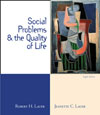CHAPTER 9 Race, Ethnic Groups, and Racism The Meaning of Race, Ethnic Groups, and Racism (pp. 292-293) We cannot use skin color to establish biological superiority, inferiority,
or even race. It is, in fact, a relatively minor biological characteristic.
Because there are so many shades of skin color, classifying a person as a member
of one or another race on that basis is rather arbitrary. Some observers think
race is a myth. Other biological characteristics by which people could
be arbitrarily classified include blood type, Rh factor, tasting ability, and
so forth. Nevertheless, to the extent that skin color is used as a basis for
race identification, the consequences are indeed serious for the society and
all its members, regardless of race. Extent and Origin of Races and Racism in America (pp. 294-297) It is estimated that, by the middle of the 21st century, half of the American
population may be something other than non-Hispanic whites. African Americans
continue to be the largest minority group, comprising 12.5 percent of the population;
the American Indian population has increased considerably, tripling between
1960 and 1990; next to Asians and Pacific Islanders, people of Hispanic origin
recorded the highest growth rate since 1980, and may be the largest minority
group by 2020. Segregation is still the predominant pattern, although the patterns
are changing. The American dream of equal opportunity in the context of freedom
from discrimination is still that--a dream. Race, Ethnicity, and the Quality of Life (pp. 297-312) All minorities have endured similar difficulties, for being defined as "nonwhite"
affects their quality of life in at least four ways: The right of citizenship
includes the right to vote, to live in a land governed by laws rather than by
individuals, and the right to equality before the law. The right to equal economic
opportunities includes equal access to employment and income-earning prospects.
The right to life, liberty, and the pursuit of happiness includes the notion
of life chances and the freedom from fear. The fourth right involves one's dignity
as a human being. This last right is frequently undermined by certain myths,
such as "success is just around the corner," the myth of inferiority, and the
myth of mongrelization. The text mentions the phenomenon of stealth racism,
which involves hidden or subtle acts of prejudice and discrimination, acts that
may only be apparent to the victim. The most recent attempt to argue for innate
inferiority involves the work of Hernnstein and Murray (The Bell Curve),
and their work has been the subject of continued criticism from other scientists.
There is evidence that contradicts the argument of genetic superiority. Contributing Factors (pp. 313-324) The term institutional racism refers to established policies and practices
of social institutions that tend to perpetuate racial discrimination. Institutional
racism virtually guarantees that certain minorities will be shortchanged by
those in power. Historically, discrimination has been perpetuated in the realms
of the mass media, education, the economy, and the government. Social psychological
factors include majority perspectives that involve the fallacy of the appeal
to prejudice and minority perspectives that involve the members of these groups
accepting their low position rather than struggling against it. Although public
attitudes appear to gradually reflect declining prejudice, Jeffrey Hadden points
to the "new American dilemma." In brief, while many Americans have come to realize
inequities and injustices of the past, and to "know better," they nevertheless
fail to implement these new attitudes in concrete ways. Many individuals remain
reluctant to back up personal convictions with public action. The fight for
all humankind must continue within schools, churches, legislatures, industry,
and the mass media. What Is to Be Done? (pp. 325-326) Minority groups themselves have launched an attack on the forces that discriminate
against them to the detriment of their desired quality of life. The result has
been intergroup conflict as minorities strive to alter values, attitudes, ideologies,
and social structural arrangements. Furthermore, attitudes and ideologies can
be changed through education, minorities can continue to mobilize for political
action, equal educational opportunities must be guaranteed to all minorities,
legislation must be continually introduced, and institutional racism must continue
to be opposed. |



 2002 McGraw-Hill Higher Education
2002 McGraw-Hill Higher Education